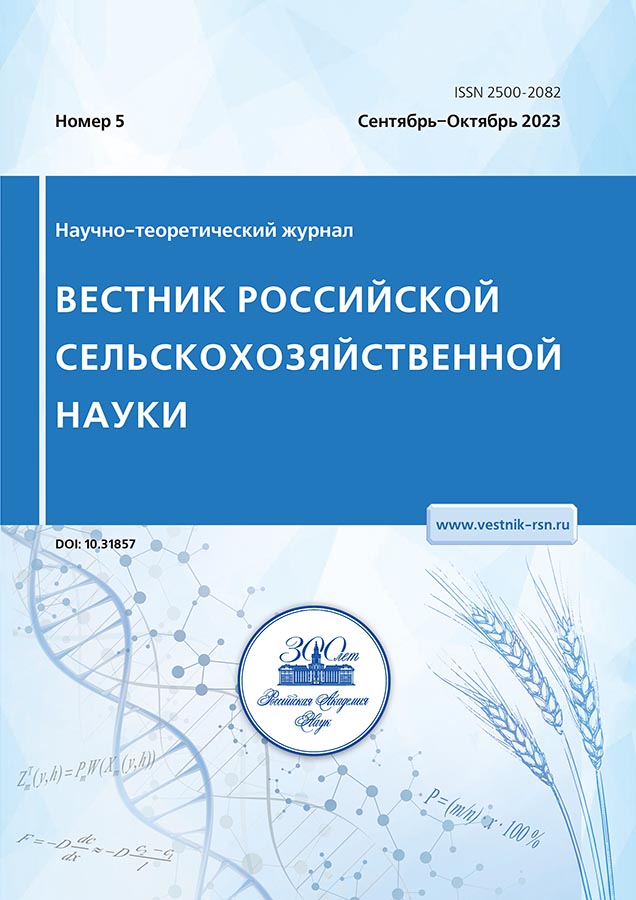SUSCEPTIBILITY TO CERTAIN TYPES OF SCAB IN THE KARELIA’S CONDITIONS
Abstract
The article presents the results of a three-year field experiment to study potato yields, as well as the incidence of Kholmogorsky (early ripening) and Nevsky (middle early) varieties with black scurf and silver scurf when planting visually infection-free seed tubers with varying degrees of growth cracks. Tuber cracking can be caused by abiotic, biological and anthropogenic factors. Tuber cracking leads to a decrease in the marketability, an increase in waste during mechanical peeling of potatoes, an increase in the likelihood of its infection with pathogens. It was found that the maximum shortage of the crop was detected with the greatest degree of fracturing of the seed material. The use of tubers with such a defect for planting caused a 1.1–fold decrease in the yield of the studied varieties relative to the controls - without growth cracks. With the intensification of the development of functional disease on potatoes, the prevalence of black scurf increased (by 8.3) and silver scurf (7.6%), especially in the early-maturing Kholmogorsky variety.
References
2. Banadysev S.A. Rostovye treshchiny i duplistost' klubnej kartofelya: vozmozhnosti kontrolya // Nashe sel'skoe hozyajstvo. 2020. № 23 (247). S. 36–43.
3. Bolezni, vrediteli, sornyaki kartofelya i meropriyatiya po bor'be s nimi / V.N. Zejruk, S.V. Zhevora, S.V. Vasil'eva i dr. M.: FGUP «Izdatel'stvo «Nauka», 2020. 332 s.
4. Volkov D.I., Kim I.V., Gisyuk A.A., Klykov A.G. Ocenka sortov kartofelya dal'nevostochnoj selekcii na prigodnost' k pererabotke // Vestnik KrasGAU. 2020. № 3. S. 44–51. DOI: 10.36718/1819-4036-2020-3-44-51.
5. Gosudarstvennyj reestr selekcionnyh dostizhenij, dopushchennyh k ispol'zovaniyu. T. 1. «Sorta rastenij» (oficial'noe izdanie). M.: FGBNU «Rosinformagrotekh», 2022. 646 s.
6. Dospekhov B.A. Metodika polevogo opyta. M.: Kolos, 1979. 416 s.
7. Evstratova L.P., Nikolaeva E.V., Permyakova V.N. Atlas boleznej i vreditelej kartofelya. Petrozavodsk: Izd-vo PetrGU, 2006. 214 s.
8. Komarova L.V. Rastreskivanie klubnej kartofelya – prichiny i sposoby ustraneniya. Tekst: elektronnyj // Agrohiminvest-NN. Sredstva zashchity rastenij. Nizhnij Novgorod, 2019. URL: https://agro-nn.ru/novosti/rastreskivanie-klubnej-kartofelya-prichiny-i-sposoby-ustraneniya/ (data obrashcheniya: 14.02.2023).
9. Kuznecova M.A. Zashchita kartofelya // Prilozhenie k zhurnalu Zashchita i karantin rastenij. 2007. № 5. 28 s.
10. Losev A.P. Praktikum po agrometeorologicheskomu obespecheniyu rastenievodstva. S.-Pb.: Gidrometeoizdat, 1994. 245 s.
11. Metodicheskie ukazaniya po ocenke selekcionnogo materiala kartofelya na ustojchivost' k fitoftorozu, rizoktoniozu, bakterial'nym boleznyam i mekhanicheskim povrezhdeniyam. M.: VASKHNIL, 1980. 53 s.
12. Metodicheskie ukazaniya po ocenke sortov kartofelya na prigodnost' k pererabotke i hraneniyu / Sost. K.A. Pshechenkov, O.N. Davydenkova, V.I. Sedova i dr. M.: VNIIKKH, 2008. 39 s.
13. Nazarova L.P. Immunologicheskij analiz genofonda kartofelya po ustojchivosti k rizoktoniozu dlya celej selekcii: avtoref. dis. … kand. s.-h. nauk. Leningrad, 1986. 18 s.
14. Perceva E.V., Percev S.V. Sortovaya ustojchivost' kartofelya k zabolevaniyam klubnej // Innovacionnye dostizheniya nauki i tekhniki APK: sbornik nauchnyh trudov. Kinel': RIO Samarskogo GAU, 2020. S. 108–111.
15. Filippov A.V., Spiridonov Yu.Ya. Gerbicidnye toksikozy kartofelya // Zashchita i karantin rastenij. 2014. № 3. S. 44–46.
16. Hohryakov M.K., Potlajchuk V.I., Semenov A.Ya., Elbakyan M.A. Opredelitel' boleznej sel'skohozyajstvennyh kul'tur. Leningrad: Kolos, 1984. 304 s.
17. Carnegie S.F., McCreath M. Mosaic virus symptoms in potato crops and the occurrence of growth cracking in tubers // European Potato Journal. 2010. № 53(1). R. 17–24. DOI:10.1007/s11540-010-9147-0.
18. Muzhinji N., Woodhall J.W., Truter M., Waals J.E. Elephant hide and growth cracking on potato tubers caused by Rhizoctonia solani AG3-PT in South Africa // Plant Disease. 2014. Vol. 98. № 4. P. 570. DOI:10.1094/PDIS-08-13-0815-PDN.
19. Mackerron D.K.L., Jefferies R.A. Observations on the effects of relief of late water stress in potato // Potato Res. 1985. T. 28. № 3. R. 349–359.
20. Mogen K.L., Nelson D.C. Some anatomical and physiological potato tuber characteristics and their relationship to hollow heart // Am. Potato J. 1986. T. 63. № 11. R. 609–618.
21. Parker A. Evaluation of potato cultivar resistance to common scab, black scurf and tuber chacking // Ann. appl. Biol. 1986. Vol. 108. № 2. P. 158–159.
22. Singh R.K., Sharma J., Singh S., Singh S.N. Reducing over-size and cracked tubers in seed potato crop through dates of haulm killing // J. Indian Potato Assn. 2007. Vol. 34. № 1–2. P. 135–136.
23. Weber J., Vetter A. Einfluss der beregnung auf die nassbfaulegefahrdung der kartoffelknollen // Arch. Acker-Pflanzenbau Bodenk. 1989. T. 33. № 7. R. 413–417.


